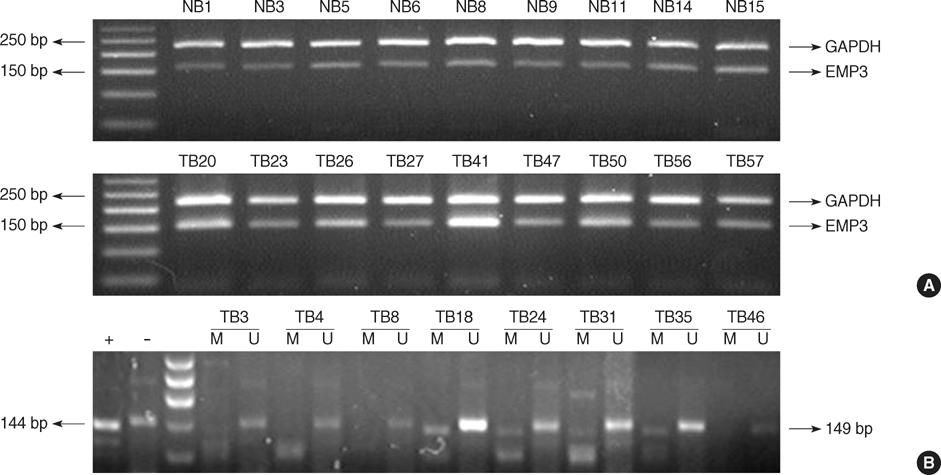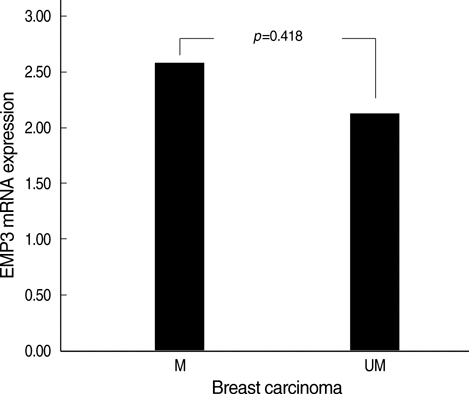J Korean Med Sci.
2009 Feb;24(1):97-103. 10.3346/jkms.2009.24.1.97.
EMP3 Overexpression in Primary Breast Carcinomas is not Associated with Epigenetic Aberrations
- Affiliations
-
- 1Department of Radiation Oncology, Shandong Tumor Hospital, Shandong University, Shandong, China.
- 2Department of Radiation Oncology, Shandong Cancer Hospital and Institute, Shandong, China. dryujinming@hotmail.com
- 3Department of Neurosurgery, Qilu Hospital, Shandong University, Shandong, China.
- 4Breast Center, Shandong Cancer Hospital and Institute, Shandong, China.
- 5Department of Immunology, Institute of Basic Medicine, Shandong Academy of Medical Sciences, Shandong, China.
- 6Cancer Center, Qilu Hospital, Shandong University, Shandong, China.
- KMID: 1794413
- DOI: http://doi.org/10.3346/jkms.2009.24.1.97
Abstract
- Epithelial membrane protein 3 (EMP3) is a trans-membrane signaling molecule with important roles in the regulation of apoptosis, differentiation and invasion of cancer cells, but the detailed is largely still unknown. We analyzed the mRNA levels and methylation statuses of EMP3 in 63 primary breast carcinomas and assessed their correlations with clinicopathologic variables. The expression of EMP3 mRNA in primary breast carcinomas was significantly higher than the expression of 20 normal breast tissues (p<10(-7)). EMP3 overexpression in breast carcinomas was significantly related to histological grade III (p=3.9X10(-7)), lymph node metastasis (p= 0.003), and strong Her-2 expression (p=3.3X10(-6)). Hypermethylation frequencies of EMP3 were detected in 36.5% of breast carcinomas by methylation-specific polymerase chain reaction. However, no significant correlations were found between methylation status of EMP3 and mRNA expression levels as well as other clinical parameters. In conclusion, EMP3 may be a novel marker of tumor aggressiveness. Overexpression of EMP3 in primary breast carcinoma is not associated with DNA methylation.
Keyword
MeSH Terms
-
Adult
Breast Neoplasms/*genetics/pathology
Carcinoma/*genetics/pathology
DNA Methylation
Epigenesis, Genetic
Female
Gene Expression Regulation, Neoplastic
Humans
Lymphatic Metastasis
Membrane Glycoproteins/*genetics/metabolism
Middle Aged
Neoplasm Staging
RNA, Messenger/metabolism
Receptor, erbB-2/genetics/metabolism
Severity of Illness Index
Figure
Reference
-
1. Taylor V, Suter U. Epithelial membrane protein-2 and epithelial membrane protein-3: two novel members of the peripheral myelin protein 22 gene family. Gene. 1996. 175:115–120.
Article2. Ben-Porath I, Kozak CA, Benvenisty N. Chromosomal mapping of Tmp (Emp1), Xmp (Emp2), and Ymp (Emp3), genes encoding membrane proteins related to Pmp22. Genomics. 1998. 49:443–447.3. Ben-Porath I, Benvenisty N. Characterization of a tumor-associated gene, a member of a novel family of genes encoding membrane glycoproteins. Gene. 1996. 183:69–75.
Article4. Mackay A, Jones C, Dexter T, Silva RL, Bulmer K, Jones A, Simpson P, Harris RA, Jat PS, Neville AM, Reis LF, Lakhani SR, O'Hare MJ. cDNA microarray analysis of genes associated with ERBB2 (HER2/neu) overexpression in human mammary luminal epithelial cells. Oncogene. 2003. 22:2680–2688.
Article5. Evtimova V, Zeillinger R, Weidle UH. Identification of genes associated with the invasive status of human mammary carcinoma cell lines by transcriptional profiling. Tumour Biol. 2003. 24:189–198.
Article6. Schiemann S, Ruckels M, Engelholm LH, Schwirzke M, Brunner N, Weidle UH. Differential gene expression in human mammary carcinoma cells: identification of a new member of a receptor family. Anticancer Res. 1997. 17:13–20.7. Robertson KD. DNA methylation, methyltransferases, and cancer. Oncogene. 2001. 20:3139–3155.
Article8. Alaminos M, Davalos V, Ropero S, Setien F, Paz MF, Herranz M, Fraga MF, Mora J, Cheung NK, Gerald WL, Esteller M. EMP3, a myelin-related gene located in the critical 19q13.3 region, is epigenetically silenced and exhibits features of a candidate tumor suppressor in glioma and neuroblastoma. Cancer Res. 2005. 65:2565–2571.
Article9. Li KK, Pang JC, Chung NY, Ng YL, Chan NH, Zhou L, Poon WS, Ng HK. EMP3 overexpression is associated with oligodendroglial tumors retaining chromosome arms 1p and 19q. Int J Cancer. 2007. 120:947–950.
Article10. World Health Organisation. International Histological Classification of Tumours No. 2. Histological typing of breast tumours. 1981. 2nd ed. Geneva: World Health Organisation.11. Caldeira JR, Prando EC, Quevedo FC, Neto FA, Rainho CA, Rogatto SR. CDH1 promoter hypermethylation and E-cadherin protein expression in infiltrating breast cancer. BMC Cancer. 2006. 6:48.
Article12. Hwang KT, Han W, Bae JY, Hwang SE, Shin HJ, Lee JE, Kim SW, Min HJ, Noh DY. Downregulation of the RUNX3 gene by promoter hypermethylation and hemizygous deletion in breast cancer. J Korean Med Sci. 2007. 22:Suppl. S24–S31.
Article13. Livak KJ, Schmittgen TD. Analysis of relative gene expression data using real-time quantitative PCR and the 2(-Delta Delta C(T)) Method. Methods. 2001. 25:402–408.14. Goelz SE, Hamilton SR, Vogelstein B. Purification of DNA from formaldehyde fixed and paraffin embedded human tissue. Biochem Biophys Res Commun. 1985. 130:118–126.
Article15. Grunau C, Clark SJ, Rosenthal A. Bisulfite genomic sequencing: systematic investigation of critical experimental parameters. Nucleic Acids Res. 2001. 29:E65–E65.
Article16. Wilson HL, Wilson SA, Surprenant A, North RA. Epithelial membrane proteins induce membrane blebbing and interact with the P2X7 receptor C terminus. J Biol Chem. 2002. 277:34017–34023.
Article17. Huhne K, Park O, Liehr T, Rautenstrauss B. Expression analysis of thö PMP22 gene in glioma and osteogenic sarcoma cell lines. J Neurosci Res. 1999. 58:624–631.18. Baylin SB, Herman JG, Graff JR, Vertino PM, Issa JP. Alterations in DNA methylation: a fundamental aspect of neoplasia. Adv Cancer Res. 1998. 72:141–196.19. Burmester JK, Suarez BK, Lin JH, Jin CH, Miller RD, Zhang KQ, Salzman SA, Reding DJ, Catalona WJ. Analysis of candidate genes for prostate cancer. Hum Hered. 2004. 57:172–178.
Article20. Kunitz A, Wolter M, van den Boom J, Felsberg J, Tews B, Hahn M, Benner A, Sabel M, Lichter P, Reifenberger G, von Deimling A, Hartmann C. DNA hypermethylation and aberrant expression of the EMP3 gene at 19q13.3 in Human Gliomas. Brain Pathol. 2007. 17:363–370.
Article
- Full Text Links
- Actions
-
Cited
- CITED
-
- Close
- Share
- Similar articles
-
- Expression and Role of Epithelial Membrane Proteins in Tumorigenesis of Hormone Receptor-Positive Breast Cancer
- Epigenetic Silencing of MORT Is an Early Event in Cancer and Is Associated with Luminal, Receptor Positive Breast Tumor Subtypes
- Mammographic, Sonographic, and MRI Features of Primary Neuroendocrine Carcinoma of the Breast: A Case Report
- Genomic DNA Aberration Profiles in Paraffin-Embedded Breast Tumor Using Array-CGH on c-erbB-2 Overexpression
- Cyclin D1 Expression in 101 Cases of Breast Carcinoma



